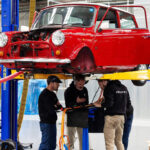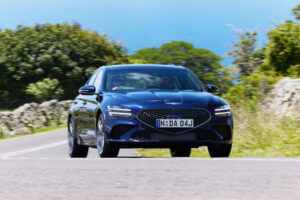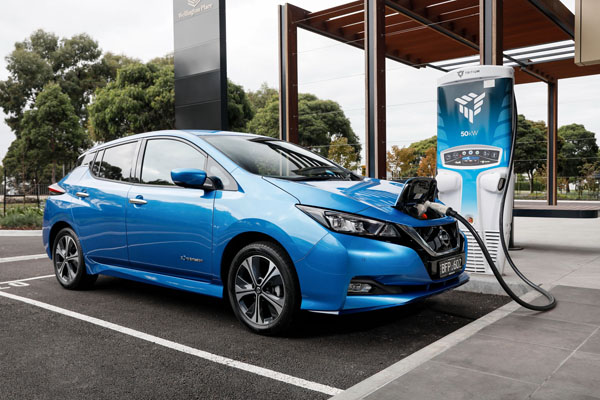
Nissan’s first pure electric vehicle, the Leaf, was launched in 2010 arriving in Australia two years later. Since then, more than half a million have been sold, making it one of the most popular EVs in the world.
The second-generation Leaf was released in 2017 but didn’t arrive here until mid-2019. With competition starting to hot up in the EV segment Nissan has recently added a more powerful and longer-range version called the Leaf e+.
These enhancements come at price with the 62 kW e+ selling for $60,490 compared with the standard 40 kW Leaf at $49,990. On-road costs need to be added and, anyone who pays that sort of money for an EV, will more than likely fork out the extra couple of grand to have a fast charger installed at their home and/or office.
STYLING
Nissan has chosen a mainstream compact SUV styling for Leaf rather than trying to make an environmental statement by being noticeably different as was the case with early hybrids.
Its lines are clean and simple with a sloping roofline, boomerang-shaped headlights and blacked-out B and C pillars.
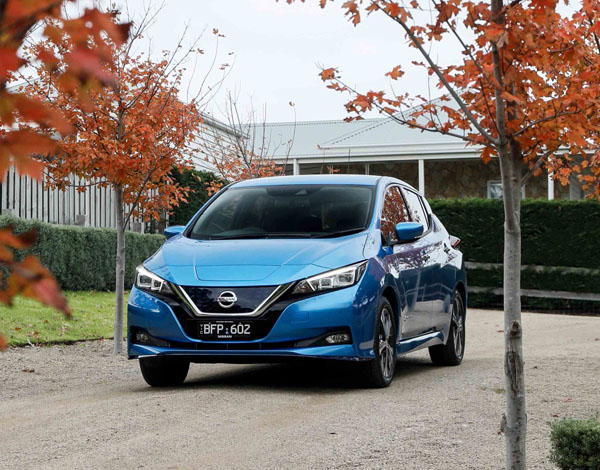
The only exterior clues to what makes the Leaf tick are ‘zero emission’ badges on the sides and rear and a solid glass cover with the Nissan badge over what otherwise would be the company’s V-motion radiator grille.
INTERIOR
Rear seat space is fairly cramped with just enough leg and headroom for two taller occupants but a third adult in the centre would be wedged between the other two, made worse with a tall transmission tunnel on the floor. The seats also sit higher than the fronts due to the storage of the battery below them.
Also missing from the rear are a folding armrest, air vents and USB ports.
Boot space is a pretty good 405 litres, or would be but for the two charging cables and Bose audio located there. The loading lip is quite high and, although the 60/40 split rear seatbacks can be folded down to extend storage to 1776 litres, they sit around 10 cm higher than the boot floor.
The spare wheel is a space-saver which is bolted under the rear of the car.
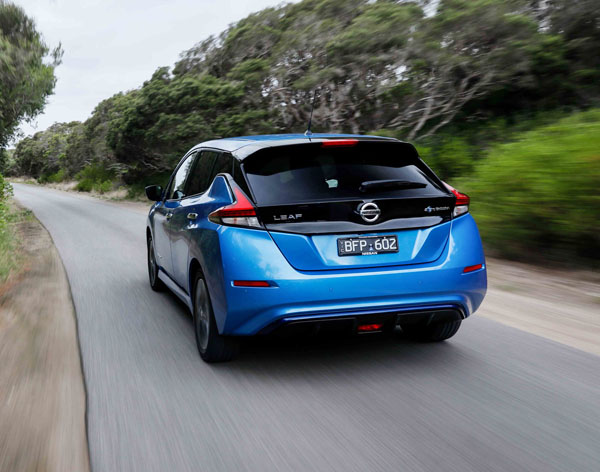
Having struggled recently in other vehicles with so-called advanced interior layouts that need constant tapping on small keys and the resultant distraction, we loved the simple, sensible and safe layout of the Leaf. There are four large round knobs in easy reach – two for audio volume / channel change and two for air con temperature / fan speed.
POWERTRAIN
The Leaf e+ is powered by a 62 kWh lithium-ion battery that generates maximum power and torque outputs of 160 kW and 340 Nm. Courtesy of the instant torque that is a feature of all hybrids of EVs it can get to 100km/h in just 6.9 seconds.
There are two charging sockets located under a small hatch at the front of the bonnet that can be unlocked either from a switch in the dashboard or a button on the key fob.
Wall box charging 12 hours or 32 hours from a standard power point. Fast charger from 90 minutes.
Both Leaf variants come with bi-directional charging, meaning that energy can not only flow from the charger to the vehicle, but can also be returned back to a home or other premise as and when required.
SAFETY
Both Nissan Leaf variants have the same impressive list of safety features that include forward collision warning; intelligent emergency braking with pedestrian detection; lane departure warning; around view monitor with moving object detection; adaptive cruise control; rear cross-traffic alert; driver inattention alert; high beam assist; blind spot warning;
front and rear parking sensors; and Isofix child seat mounts on the outer rear seats.
INFOTAINMENT
Both Leaf models come with the NissanConnect infotainment system, with an 8.0-inch touchscreen in the centre of the dashboard. It includes embedded satellite navigation which includes the location of the nearest public charging stations. Both Apple CarPlay and AndroidAuto are available.
There are two screens, an 8.0-inch touchscreen for infotainment functions in the centre of the dash and a 7.0-inch multifunction display in front of the driver.
There is a single USB port located directly above a deep opening that’s perfectly sized for storage of a smartphone.
DRIVING
Only a tiny number of Aussies have ever driven an electric car and one of the most common questions we are asked is about their performance with the prevailing view being that they must be slow and sluggish.
Take them for a drive and it takes about a second to ally that concern with the instant torque immediately sending the Leaf e+ on its way. It’s the sort of performance you could expect in the past from a V8 – but without the accompanying noise and pollution.
Its compact dimensions make it easy to park. To ensure that passers-by are aware that the car is being reversed there’s an unusual pinging sound emitted from the rear.
We love the ability, with most new electric cars, to effectively drive by just using the accelerator pedal. In the Leaf models it’s called the e-Pedal which is activated by a switch in the centre console.
By reducing the pressure on the accelerator, the speed can be reduced gradually or rapidly by taking the foot off altogether. It takes some practice but is a satisfying way to drive especially around town given the added benefit that through regenerative braking the battery is being charged.
We found that, in motorway conditions, the extra pressure needed to maintain traffic speed negated the benefit of the e-Pedal and we tended to use it only on downhill running.
The biggest surprise with a vehicle that will no doubt spend most of its time in and around urban areas is how impressive it was out on the open road. Its ride and handling are excellent and the torque pick up will appeal to keen drivers. The absence of any engine sound combined with good external noise suppression and much less range anxiety adds further to the driving enjoyment.
Nissan lists a 385-kilometre range for the Leaf e+. During our week behind the wheel we found that dropping rapidly when we drove more aggressively, much as occurs with fuel consumption from conventional engines. However, on our return trip to Sydney from the Central Coast, we were able to see the range reduction almost identical to the distance travelled.
Our Queensland team will be testing the e+ in a couple of months and no doubt will be looking to take the range over that 385 km target.
SUMMING UP
Price and range have always been the two main barriers to electric vehicle sales and until the first comes down and the other goes up EVs will remain a rarity on Australian roads.
While the Leaf e+ does provide a significantly better range and performance it adds $10,500 to the price of standard Leaf. Despite its $60,490 tag it only gets cloth seats and no powered adjustment for the front seats although they are heated.
For much of its decade on the market Leaf has had little competition. That’s rapidly changing with Hyundai and Kia now mounting serious challenges so the timing of the arrival of the e+ could prove vital for Nissan.
AT A GLANCE
MODEL RANGE
Nissan LEAF: $49,990
Nissan LEAF e+: $60,490
Note: These prices do not include government or dealer delivery charges. Contact your local Nissan dealer for drive-away prices.
SPECIFICATIONS (Nissan Leaf 62kWh lithium-ion 350V battery, five-door wagon)
POWERTRAIN
Capacity: 62kWh
Configuration:Lithium-ion battery, AC synchronous motor, reduction drive
Maximum Power: 160 kW
Maximum Torque: 340 Nm
Fuel type: Electric
Driving range: 385 km
CO2 emissions: zero g / km
DRIVELINE:
Drivetrain: Reduction drive, shift by wire, 2WD
DIMENSIONS, WEIGHT AND CAPACITIES:
Length: 4490 mm
Width: 2030 mm including mirrors
Height: 1540 mm
Wheelbase: 2700 mm
Kerb weight: 1594 kg
BRAKES:
Front: Ventilated Disc
Rear: Ventilated Disc
STANDARD WARRANTY:
Five years / unlimited kilometres. Eight years on the battery.




